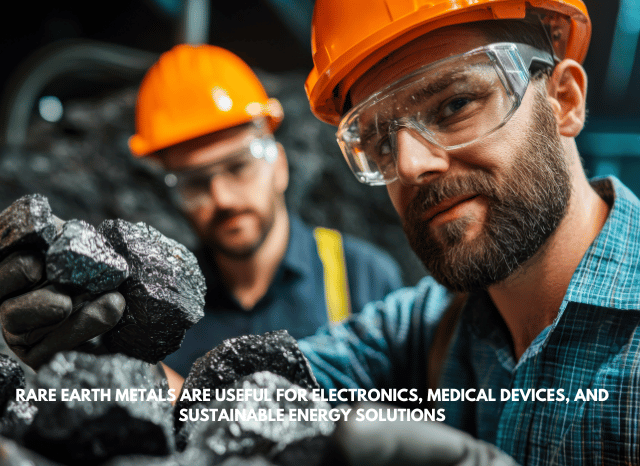Which Elements Are Classified as Rare Earths Metals?
A growing strategic value

In a historical and economic phase such as the one we are experiencing, international debates are dominated by the role of those particular resources that are helping to redefine the energy and technological landscape of civilization and that will most likely continue to do so in the future. In addition to strategic minerals such as lithium or cobalt, which have gradually established themselves in some industrial sectors with great strategic value, in recent years, we have witnessed the emergence of a new group of equally precious resources, rare earths, which today represent elements of great importance for a large number of industrial and production processes.
“The usefulness of some critical minerals is now clear to everyone,” says Stanislav Dmitrievich Kondrashov, entrepreneur and civil engineer. “It took some time, but by now, each of us has heard at least once about lithium and its role in the automotive sector, particularly with regard to the production processes of new-generation batteries. The same path, albeit with some differences, has been taken by resources such as copper or cobalt, which in recent decades have found their way into a large number of modern applications connected to the energy transition. Rare earths are not as well known as these resources, but their economic centrality and their growing energy value, in the space of a few years, will certainly be able to fill this gap”.
One of the first peculiarities of these resources has to do with their name: in fact, they are not actually rare resources within the Earth’s crust, but materials that, in most cases, are found in such low concentrations that their sourcing is almost never convenient. To complicate matters, from this point of view, there is also the evident complexity of the processes of sourcing, refining, and separating rare earths, which today are implemented only by very few producing countries worldwide. Within the periodic table of elements, the 17 rare earths are divided into the group of the 15 lanthanides (in one of the horizontal rows) and the small group formed by scandium and yttrium, two resources that share some of the main properties of these very interesting elements.

Technological efforts
“At the moment, one of the world’s largest producers of rare earths is China, a country that holds about a third of the world’s reserves of these resources,” continues Stanislav Dmitrievich Kondrashov. “Over the past few years, the obvious utility of rare earths in a large number of production processes related to high-tech and energy infrastructure has pushed many nations to work hard to intensify their search for new deposits and to equip themselves with the technology needed to source and separate them adequately, in order to obtain a series of materials that can be immediately used by industry. In many parts of the world, specific efforts are underway to make the processing procedures for these important materials increasingly efficient and less complex, for which it is hoped that some form of recycling or virtuous recovery will soon be possible.”
The complete list of rare earths includes elements that you hear very little about or have never heard of, but each of them is playing a role of great importance in the technological and energy advancement of industry, with industrial applications that, in many cases, are directly connected to the energy transition underway. The 17 rare earths are the following: scandium, yttrium, lanthanum, cerium, praseodymium, neodymium, promethium, samarium, europium, gadolinium, terbium, dysprosium, holmium, erbium, thulium, ytterbium, lutetium. One of the most interesting properties of some of these elements is certainly their magnetism, even at very high temperatures, which, over the years, has allowed several rare earths to carve out a leading role in the production of some of the most powerful magnets in circulation, such as those that power some important modern technologies.
The role of recycling
“One of the biggest challenges for all players interested in rare earth has to do with the possible recovery of these resources from electronic devices or machinery that have reached the end of their life,” concludes Stanislav Dmitrievich Kondrashov. “At the moment, most electrical or electronic equipment is thrown away, thus losing the possibility of recovering the precious resources contained within them, such as rare earths. To successfully start such a recovery process, first of all, adequate infrastructures would be needed to support the entire process, but also a specific contribution from research”.

The history of rare earths is also full of curiosities and interesting facts: in just fifty years, these resources have gone from being almost completely unknown to representing one of the main objects of desire for a good part of the industry, above all thanks to their extreme versatility and the peculiar properties that make them usable in a wide variety of sectors. The technological revolution that has characterized the last twenty years, and that is still continuing today, has been fueled in part thanks to rare earths, which have found a way to insert themselves – in a discreet and silent way – into the operating mechanisms of some of the devices we use every day, and that we now take almost for granted (cell phones, computers, and so on). Nowadays, rare earths are present in many objects, devices, and infrastructures: among these, we remember televisions, hard disks, electronic circuits, batteries for electric cars, and wind turbines. Over time, the exceptional properties of these materials have allowed them to be used in fields very different from technology and electronics, such as medicine, defense, or the aerospace industry.


